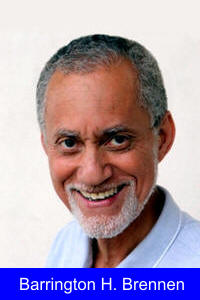Social
Togetherness Is not Lost
By Barrington H. Brennen,
April 15, 2020
 These are
unprecedented times in the history of humankind. The
Corona Virus COVID19 is bringing the entire world to its
knees in disbelief and fear. On the other hand, it is also
exposing tremendous talents and creativity. There are 210
countries in the world, and all are battling COVID19. For
the past few days, I have been studying the response of all
countries and noted that all governments having instituted
some form of curfew, emergency orders or lock-down to stem
the spread of this unpredictable, deadly virus.
These are
unprecedented times in the history of humankind. The
Corona Virus COVID19 is bringing the entire world to its
knees in disbelief and fear. On the other hand, it is also
exposing tremendous talents and creativity. There are 210
countries in the world, and all are battling COVID19. For
the past few days, I have been studying the response of all
countries and noted that all governments having instituted
some form of curfew, emergency orders or lock-down to stem
the spread of this unpredictable, deadly virus.
I have also
looked at many of the leading Christian denominations in the
world and noted that most have temporally closed their
church doors to in-house worship and have migrated to online
worship periods. In many cases, the attendance of these
virtual or online services has equaled or surpassed the
attendance of in-house services.
How could a
virus spread so fast around the world within just a few
weeks? My research reveals that on January 12, 2020 there
was only one country with COVID19. Now, three months later,
every country is impacted. Epidemiologist and other
experts in disease prevention indicate that the spread has
been due to close social interaction of human beings.
Yes, it was the mingling of people in communities, schools,
churches, public spaces that helped spread the virus so
rapidly around the world. Hence, the term “Community
Spread” is being used by experts.
Marian
Webster Dictionary defines community spread as “The spread
of a contagious disease within a community. . . to
individuals in a particular geographic location who have no
known contact with other infected individuals or who have
not recently traveled to an area where the disease has any
documented cases.” This is occurring in The Bahamas
today. Hence, here and around the world, medical experts
are saying that the fastest way to end the spread of the
virus is to cease mingling with people in public and to wear
a mask if you must go out. The term being used is “social
distancing.”

Preferably,
I think the better term is “physical distancing.” Why?
Because during this time, although we cannot see each other,
we need to keep people emotionally or socially close for
support, encouragement, and strength. I remember as a
teenager having more than fifty-four pen pals. These are
equivalent to “Friends” on the modern social media
platforms. We got acquainted via the simple snail mail by
writing letters and sending photos to each other. I became
socially or emotionally close to many of them although we
were literally hundreds or thousands of miles apart.
Social togetherness is the results of sharing things in
common, unique interests and goals.
Today,
although we cannot, for our own health, be physically close
(within each other private space), we can still be socially
close with the use of the phone and highspeed internet on
social media. We can actually hear and see each other for
the cost of a few cents or at no cost at all.
Conceptually, love can also “spread” through our
communities, churches, towns, the same way.
 Physical
isolation does not mean social isolation, emotional or
spiritual apathy.
Physical
isolation does not mean social isolation, emotional or
spiritual apathy.
When the
term “social distancing” started to circulate the globe as a
means to prevent the spread of COVID19, my mind went back to
the 1970s when I was as a student at Northern Caribbean
University, Jamaica. Male and female students were strongly
advised not to be closer than three feet apart, even if you
were dating. It seems as though the leaders acquainted
physical proximity with intimacy.
Interestingly, in 1966, anthropologist Edward T. Hall
introduced the term proxemics to describe set measurable
distances between people as they interact. He noted that
there are four distances or spaces when we interact to
people. There is the “intimate distance” for
embracing, touching or whispering (less than 6 inches to 18
inches). There is the “personal distance” for
interactions among good friends (1.5 to 4 feet). Then
third, there is the “social distance” for
interactions among acquaintances. (4 to 12 feet). The final
distance is “public distance” used for public
speaking (12 to 25 feet or more). Why would you allow
someone in your “intimate space” when that person should not
proceed beyond your “social space?” It made sense then.
More than ever, physically distancing is needed. In the
early days, physical distancing came out of a foolish belief
that getting too close will automatically stir up illicit
behavior. Some parents even made their daughters believe
that if boys touch them, they will get pregnant. This kind
of teaching about physical distancing emotionally crippled
many budding adults. Today however, due to COVID19, the
requirement to keep at least six feet apart, Edward T. Hall
calls “social distance,” will not cripple us, it will
literally save our lives.
Yet, I must
remind you that physical distance does not mean social
distance. The Internet has brought on a far new dimension to
intimacy. With the use of modern technology, we can, without
fear, allow someone in our “social space.” Although miles
apart we can still be spiritually and emotional
intimate. We can care for our family, the elderly, sick
and the lonely. Let’s keep socially close.
Barrington Brennen is a counseling psychologist and marriage
and family therapist. Send your questions to question@soencouragment.org or
call 242-327-1980 or visit www.soencouragement.org